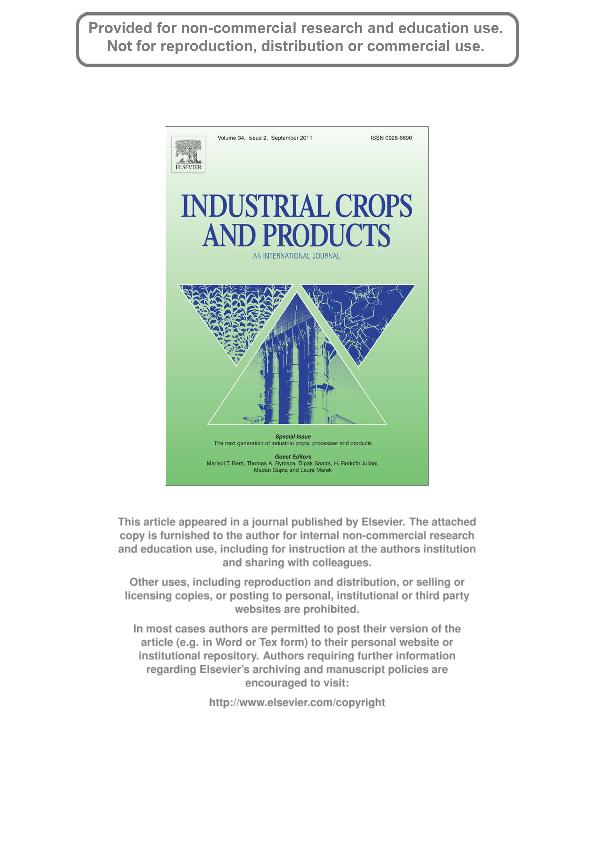Mostrar el registro sencillo del ítem
dc.contributor.author
Gomez, Nora Valentina

dc.contributor.author
Miralles, Daniel Julio

dc.date.available
2020-02-12T00:38:47Z
dc.date.issued
2011-09
dc.identifier.citation
Gomez, Nora Valentina; Miralles, Daniel Julio; Factors that modify early and late reproductive phases in oilseed rape (Brassica napus L.): Its impact on seed yield and oil content; Elsevier Science; Industrial Crops and Products; 34; 2; 9-2011; 1277-1285
dc.identifier.issn
0926-6690
dc.identifier.uri
http://hdl.handle.net/11336/97247
dc.description.abstract
Oilseed rape yield potential could be improved lengthening the duration of the late reproductive phase by increasing the number of grains per unit area. Photoperiod sensitivity could be used as a tool to manipulate the reproductive phase and thereby the number of grains. The aim of this study was to assess (i) the effects of different combinations of photoperiod on the duration of different phases and (ii) analyze how the changes in that duration affect yield (and its components) as well as oil seed content in oilseed rape. Field experiments were conducted in a factorial combination of three cultivars and three photoperiod regimes: natural photoperiod (NP) which represents the control and extended photoperiod of 6h over NP (NP+6) during emergence (E)-flower buds visible (FBV) and FBV-maturity (M) arranged in a randomized complete block design with three replicates, during two years representing three environments. Results showed that oilseed rape evidenced photoperiod responses during vegetative and early reproductive phases. Due to the lack of correlation between the duration of the vegetative and reproductive phases, it is possible to speculate the vegetative period may be altered independently of the modification of the rest of the phases. The positive relationship between grain number per m2 and the duration of the late reproductive phase suggests that yield could be increased by lengthening the duration of that phase. Thus, regardless of the effect on the previous phase, the photoperiod sensitivity found in the early reproductive phase opens the possibility to manipulate the relative durations of vegetative and reproductive phases. Therefore, the length of the reproductive phase will be increased at the expense of a reduction in the duration of the vegetative phase, but without changing the whole duration of the crop cycle. This strategy could increase yield in oilseed rape in the future. Variations in yield were mostly explained by changes in the grain number per unit area without significant correlation with grain weight. However, a negative relationship between grain weight and grain number was found, showing a slight counterbalance in yield, by decreasing the grain weight. Since oil concentration appeared to be a more conservative attribute, increases in crop yield through a higher grain number per unit area would be a suitable strategy for improving oil yield as no reductions in oil concentration can be expected.
dc.format
application/pdf
dc.language.iso
eng
dc.publisher
Elsevier Science

dc.rights
info:eu-repo/semantics/openAccess
dc.rights.uri
https://creativecommons.org/licenses/by-nc-sa/2.5/ar/
dc.subject
CROP DEVELOPMENT
dc.subject
GRAIN WEIGHT
dc.subject
NUMBER OF GRAINS
dc.subject
PHOTOPERIOD
dc.subject
RAPESEED
dc.subject
YIELD
dc.subject.classification
Agricultura

dc.subject.classification
Agricultura, Silvicultura y Pesca

dc.subject.classification
CIENCIAS AGRÍCOLAS

dc.title
Factors that modify early and late reproductive phases in oilseed rape (Brassica napus L.): Its impact on seed yield and oil content
dc.type
info:eu-repo/semantics/article
dc.type
info:ar-repo/semantics/artículo
dc.type
info:eu-repo/semantics/publishedVersion
dc.date.updated
2020-02-07T13:48:19Z
dc.journal.volume
34
dc.journal.number
2
dc.journal.pagination
1277-1285
dc.journal.pais
Países Bajos

dc.journal.ciudad
Amsterdam
dc.description.fil
Fil: Gomez, Nora Valentina. Universidad de Buenos Aires. Facultad de Agronomía. Departamento de Producción Vegetal. Cátedra de Cultivos Industriales; Argentina. Consejo Nacional de Investigaciones Científicas y Técnicas. Oficina de Coordinación Administrativa Parque Centenario. Instituto de Investigaciones Fisiológicas y Ecológicas Vinculadas a la Agricultura. Universidad de Buenos Aires. Facultad de Agronomía. Instituto de Investigaciones Fisiológicas y Ecológicas Vinculadas a la Agricultura; Argentina
dc.description.fil
Fil: Miralles, Daniel Julio. Universidad de Buenos Aires. Facultad de Agronomía. Departamento de Producción Vegetal. Cátedra de Cerealicultura; Argentina. Consejo Nacional de Investigaciones Científicas y Técnicas. Oficina de Coordinación Administrativa Parque Centenario. Instituto de Investigaciones Fisiológicas y Ecológicas Vinculadas a la Agricultura. Universidad de Buenos Aires. Facultad de Agronomía. Instituto de Investigaciones Fisiológicas y Ecológicas Vinculadas a la Agricultura; Argentina
dc.journal.title
Industrial Crops and Products

dc.relation.alternativeid
info:eu-repo/semantics/altIdentifier/doi/https://doi.org/10.1016/j.indcrop.2010.07.013
dc.relation.alternativeid
info:eu-repo/semantics/altIdentifier/url/https://www.sciencedirect.com/science/article/pii/S0926669010001913
Archivos asociados
